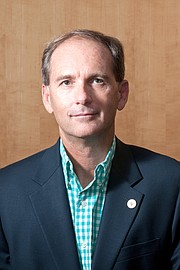By NEIL HARTNELL
Tribune Business Editor
nhartnell@tribunemedia.net
The Bahamas must “work like hell” to achieve higher GDP growth rates after data released yesterday revealed the economy has finally exited a six-year stall.
Robert Myers, the Organisation for Responsible Governance’s (ORG) principal, told Tribune Business that his businesses had taken a decade to recover “to pre-2008 levels last year” as the Department of Statistics disclosed that real economic output had now returned to 2012 levels.
Its report exposed that The Bahamas has undershot growth projections by the International Monetary Fund (IMF) and others, with real GDP expanding last year by 1.6 percent compared to forecasts of 2.3 percent.
That was the figure for nominal GDP growth, which includes the impact of inflation whereas the real GDP measure strips this out. Still, the latter’s 1.6 percent expansion ensured The Bahamas just about exceeded 2012’s economic output last year, finally offsetting the economy’s three percent contraction in 2013 and five consecutive years when growth remained stubbornly below one percent.
The Department of Statistics data, taking The Bahamas’ $10.721bn economy in 2012 as a baseline, showed that economic output slumped by more than $300m the following year to $10.404bn as a result of the three-year contraction.
The Bahamas spent the next five years regaining this lost output, with real GDP growth rates ranging from a high of 0.7 percent in 2014 to a low of 0.1 percent in 2017. The “major” growth surge came in 2018 as a result of the 1.6 percent expansion, which finally moved real GDP above 2012 levels to $10.763bn.
K P Turnquest, deputy prime minister, and the Ministry of Finance yesterday hailed the Department of Statistics report for confirming that The Bahamas had enjoyed decent real GDP growth for the first time in five years under the Minnis administration in 2018.
The Ministry, in a statement, compared last year’s 1.6 percent real growth to the mild 0.4 per cent average GDP increase realised over the previous three years.
It added: “The economy was valued at $12.42bn in nominal dollars, with four of the 17 industry groups contributing the most to the overall size: Real estate, wholesale and retail trade, accommodation and food services, and financial and insurance services.”
Mr Turnquest, meanwhile, said: “This is the first time the country has had decent economic growth in over five years. When we look at where we are now compared to where we were, these results are confirmation there has been a significant turnaround and our policy mix is effectively placing us on a path of sustained growth.
“The key takeaways are that economic growth is positive, our momentum has firmed and it is being driven by the private sector. Just five years ago, the country was experiencing negative growth at -3 per cent and, for several years, the country struggled to arrest the decline.
“Now, we have turned things around, and we are set up for future expansion and sustained growth. This will allow for expanded job opportunities for Bahamians and improve our ability to withstand shocks.”
Mr Myers, though, argued that the Department of Statistics data illustrated the scale of the task still confronting The Bahamas to reverse decades of economic underperformance and convert this into sustainable, job-creating growth that brings unemployment down into the single digits.
“The fact is GDP matters, and we have got to do better on improving GDP growth,” he told Tribune Business. “If the Government is going to cut back on expenditure and capital investment there’s no other choice: GDP growth is the only way.
“GDP growth is the rising tide that lifts all boats. We have to work like hell to get GDP growth up as close to 5.5 percent as possible, but a lot of that is not possible in my view as workforce development and education are lagging behind and capping GDP growth.”
A 5.5 percent annual GDP growth rate was cited by the IMF as the level that The Bahamas needed to attain between 2013 and 2018 if it was to successfully absorb all new workforce entrants over that period while cutting existing unemployment rates by 50 percent.
The Department of Statistics data indicates The Bahamas remains well short of such growth, and Mr Myers added: “The workforce isn’t ready, and is not there, to get more growth. That’s why we’re so heavily dependent on foreign direct investment (FDI).
“Yes, there’s capacity to improve entrepreneurship. but with 73 percent of school leavers failing it’s very hard to get internal growth with these kind of statistics. It just indicates we still have a tremendous amount of work to do.”
Mr Myers said most Bahamian companies, including his own, had endured a protracted decade-long recession that had begun in 2008. “From our business’s standpoint it took us at least 10 years to get back to pre-2008,” he told Tribune Business. “Last year was the first time we got back to 2008 levels in the private sector.
“I can tell you that it was a very protracted, elongated recession. We’ve had a hell of a time, and just got back up in 2018. Hopefully, we will hold this growth through 2019 and 2020. We took a heavy hammering for five of those years - from 2008 to 2013. It’s not been a party for anybody, including the Government.”
He added that while the US had begun to “bounce back in 2011 and 2012”, The Bahamas had taken much longer. “In my view it’s been a 10-year recession,” Mr Myers said. “It’s just started to correct.
“2017 was getting better, but it was a long haul coming off the bottom. Most private sector companies probably mimic that, and some probably still don’t. If they only recovered in 2018, it takes a while for that money to get through the system.”





Comments
Use the comment form below to begin a discussion about this content.
Sign in to comment
Or login with:
OpenID